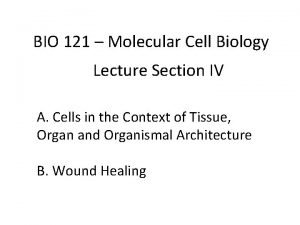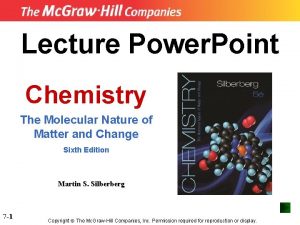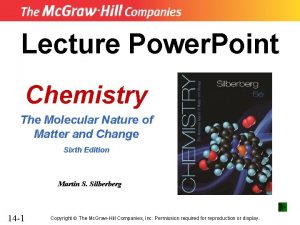Lecture Power Point Chemistry The Molecular Nature of



































































- Slides: 67

Lecture Power. Point Chemistry The Molecular Nature of Matter and Change Sixth Edition Martin S. Silberberg 9 -1 Copyright The Mc. Graw-Hill Companies, Inc. Permission required for reproduction or display.

Chapter 9 Models of Chemical Bonding 9 -2

Models of Chemical Bonding 9. 1 Atomic Properties and Chemical Bonds 9. 2 The Ionic Bonding Model 9. 3 The Covalent Bonding Model 9. 4 Bond Energy and Chemical Change 9. 5 Between the Extremes: Electronegativity and Bond Polarity 9. 6 An Introduction to Metallic Bonding 9 -3

Figure 9. 1 9 -4 A comparison of metals and nonmetals.

Types of Chemical Bonding Ionic bonding involves the transfer of electrons and is usually observed when a metal bonds to a nonmetal. Covalent bonding involves the sharing of electrons and is usually observed when a nonmetal bonds to a nonmetal. Metallic bonding involves electron pooling and occurs when a metal bonds to another metal. 9 -5

Figure 9. 2 9 -6 Three models of chemical bonding.

Figure 9. 3 9 -7 Gradations in bond type among Period 3 (black type) and Group 4 A (red type) elements.

Lewis Electron-Dot Symbols To draw the Lewis symbol for any main-group element: • Note the A-group number, which gives the number of valence electrons. • Place one dot at a time on each of the four sides of the element symbol. • Keep adding dots, pairing them, until all are used up. Example: Nitrogen, N, is in Group 5 A and therefore has 5 valence electrons. • or • N • or • N • • • • 9 -8 or • • N • •

Lewis Symbols and Bonding For a metal, the total number of dots in the Lewis symbol is the number of electrons the atom loses to form a cation. For a nonmetal, the number of unpaired dots equals - the number of electrons the atom gains to form an anion - or the number it shares to form covalent bonds. The octet rule states that when atoms bond, they lose, gain, or share electrons to attain a filled outer level of 8 electrons (or 2, for H and Li). 9 -9

Figure 9. 4 Lewis electron-dot symbols for elements in Periods 2 and 3. 9 -10

The Ionic Bonding Model An ionic bond is formed when a metal transfers electrons to a nonmetal to form ions, which attract each other to give a solid compound. The total number of electrons lost by the metal atom(s) equals the total number of electrons gained by the nonmetal atoms. 9 -11

Figure 9. 5 Three ways to depict electron transfer in the formation of Li+ and F-. Electron configurations Li 1 s 22 s 1 + F 1 s 22 p 5 → Li+ 1 s 2 + F- 1 s 22 p 6 Orbital diagrams Li ↑↓ ↑ + 1 s 2 s 2 p F ↑↓ ↑↓ ↑ 1 s 2 s 2 p Li+ F- ↑↓ 1 s 2 s 2 p ↑↓ ↑↓ ↑↓ 1 s 2 s 2 p Lewis electron-dot symbols Li+ + • • F • • 9 -12 • • Li • • F • •

Sample Problem 9. 1 Depicting Ion Formation PROBLEM: Use partial orbital diagrams and Lewis symbols to depict the formation of Na+ and O 2− ions from the atoms, and determine the formula of the compound formed. PLAN: Draw orbital diagrams and Lewis symbols for Na and O atoms. To attain filled outer levels, Na loses one electron and O gains two. Two Na atoms are needed for each O atom so that the number of electrons lost equals the number of electrons gained. SOLUTION: • • • O • Na • 9 -13 2 Na+ • • 2 O + • • Na •

Sample Problem 9. 1 Na ↑ 3 s Na + 3 p O 2 s ↑ 3 s ↑↓ 3 p 2 Na+ + O 2 - ↑↓ ↑↓ 2 s 2 p The formula is Na 2 O 9 -14 ↑↓ ↑ 2 p ↑

Figure 9. 6 Na(s) 9 -15 The exothermic formation of sodium bromide. Br 2(l) Na. Br(l)

Figure 9. 7 9 -16 The Born-Haber cycle for lithium fluoride.

Periodic Trends in Lattice Energy Lattice energy is the energy required to separate 1 mol of an ionic solid into gaseous ions. Lattice energy is a measure of the strength of the ionic bond. Coloumb’s Law Electrostatic energy 9 -17 charge A x charge B distance cation charge x anion charge cation radius + anion radius DHolattice

Periodic Trends in Lattice Energy Lattice energy is affected by ionic size and ionic charge. As ionic size increases, lattice energy decreases. Lattice energy therefore decreases down a group on the periodic table. As ionic charge increases, lattice energy increases. 9 -18

Figure 9. 8 9 -19 Trends in lattice energy.

Properties of Ionic Compounds • Ionic compounds tend to be hard, rigid, and brittle, with high melting points. • Ionic compounds do not conduct electricity in the solid state. – In the solid state, the ions are fixed in place in the lattice and do not move. • Ionic compounds conduct electricity when melted or dissolved. – In the liquid state or in solution, the ions are free to move and carry a current. 9 -20

Figure 9. 9 9 -21 Why ionic compounds crack.

Figure 9. 10 Solid ionic compound 9 -22 Electrical conductance and ion mobility. Molten ionic compound Ionic compound dissolved in water

Table 9. 1 Melting and Boiling Points of Some Ionic Compounds Compound bp (°C) Cs. Br 636 1300 Na. I 661 1304 Mg. Cl 2 714 1412 KBr 734 1435 Ca. Cl 2 782 >1600 Na. Cl 801 1413 Li. F 845 1676 KF 858 1505 2852 3600 Mg. O 9 -23 mp (°C)

Figure 9. 11 Ion pairs formed when an ionic compound vaporizes. Interionic attractions are so strong that when an ionic compound is vaporized, ion pairs are formed. 9 -24

Figure 9. 12 9 -25 Covalent bond formation in H 2.

Figure 9. 13 Distribution of electron density in H 2. At some distance (bond length), attractions balance repulsions. 9 -26 Electron density is high around and between the nuclei.

Bonding Pairs and Lone Pairs Atoms share electrons to achieve a full outer level of electrons. The shared electrons are called a shared pair or bonding pair. The shared pair is represented as a pair of dots or a line: • • H H or H–H An outer-level electron pair that is not involved in bonding is called a lone pair, or unshared pair. • • 9 -27 or • • F–F • • • • F F • •

Properties of a Covalent Bond The bond order is the number of electron pairs being shared by a given pair of atoms. A single bond consists of one bonding pair and has a bond order of 1. The bond energy (BE) is the energy needed to overcome the attraction between the nuclei and the shared electrons. The stronger the bond the higher the bond energy. The bond length is the distance between the nuclei of the bonded atoms. 9 -28

Trends in bond order, energy, and length For a given pair of atoms, a higher bond order results in a shorter bond length and higher bond energy. For a given pair of atoms, a shorter bond is a stronger bond. Bond length increases down a group in the periodic table and decreases across the period. Bond energy shows the opposite trend. 9 -29

Table 9. 2 Average Bond Energies (k. J/mol) and Bond Lengths (pm) 9 -30

Table 9. 3 The Relation of Bond Order, Bond Length, and Bond Energy 9 -31

Figure 9. 14 Internuclear distance (bond length) Bond length and covalent radius. Covalent radius Internuclear distance (bond length) 72 pm Internuclear distance (bond length) Covalent radius 100 pm 9 -32 Covalent radius 114 pm Internuclear distance (bond length) Covalent radius 133 pm

Sample Problem 9. 2 Comparing Bond Length and Bond Strength PROBLEM: Using the periodic table, but not Tables 9. 2 or 9. 3, rank the bonds in each set in order of decreasing bond length and decreasing bond strength: (a) S–F, S–Br, S–Cl (b) C=O, C–O, CΞO PLAN: (a) S is singly bonded to three different halogen atoms, so the bond order is the same. Bond length increases and bond strength decreases as the atomic radius of the halogen increases. (b) The same two atoms are bonded in each case, but the bond orders differ. Bond strength increases and bond length decreases as bond order increases. 9 -33

Sample Problem 9. 2 SOLUTION: (a) Atomic size increases going down a group, so F < Cl < Br. Bond length: S–Br > S–Cl > S–F Bond strength: S–F > S–Cl > S–Br (b) By ranking the bond orders, we get Bond length: C–O > C=O > CΞO Bond strength: CΞO > C=O > C–O 9 -34

Figure 9. 15 Strong forces within molecules and weak forces between them. 9 -35

Figure 9. 16 9 -36 Covalent bonds of network covalent solids: quartz and diamond.

Tools of the Laboratory Infrared Spectroscopy Figure B 9. 1 Vibrational motions in general diatomic and triatomic molecules. Copyright © The Mc. Graw-Hill Companies, Inc. Permission required for reproduction or display. 9 -37

Tools of the Laboratory Figure B 9. 2 9 -38 Infrared Spectroscopy The infrared (IR) spectrum of acrylonitrile.

Tools of the Laboratory Figure B 9. 3 9 -39 Infrared Spectroscopy The infrared (IR) spectra of 2 -butanol (green) and diethyl ether (red).

Tools of the Laboratory Figure B 9. 4 9 -40 Infrared Spectroscopy The infrared (IR) spectra of 1, 3 -dimethylbenzene (green) and 1, 4 -dimethylbenzene (red).

Bond Energies and Horxn The heat released or absorbed during a chemical change is due to differences between the bond energies of reactants and products. H°rxn = S H°reactant bonds broken+ S H°product bonds formed 9 -41

Figure 9. 17 9 -42 Using bond energies to calculate H°rxn for HF formation.

Figure 9. 18 9 -43 Using bond energies to calculate H°rxn for the combustion of methane.

Sample Problem 9. 3 Using Bond Energies to Calculate H°rxn PROBLEM: Calculate DH°rxn for the chlorination of methane to form chloroform. bonds broken S H° positive PLAN: 9 -44 bonds formed S H° negative All the reactant bonds break, and all the product bonds form. Find the bond energies in Table 9. 2 and substitute the two sums, with correct signs, into Equation 9. 2.

Sample Problem 9. 3 SOLUTION: For bonds broken: 4 x C-H = (4 mol)(413 k. J/mol) = 1652 k. J 3 x Cl-Cl = (3 mol)(243 k. J/mol) = 729 k. J S H°bonds broken = 2381 k. J For bonds formed: 3 x C-Cl = (3 mol)(-339 k. J/mol) = -1017 k. J 1 x C-H = (1 mol)(-413 k. J/mol) = -413 k. J 3 x H-Cl = (3 mol)(-427 k. J/mol) = -1281 k. J S H°bonds formed = -2711 k. J DH°reaction = SDH°bonds broken + SDH bonds formed = 2381 k. J + (-2711 k. J) = - 330 k. J 9 -45

Figure 9. 19 9 -46 Relative bond strength and energy from fuels.

Table 9. 4 Enthalpies of Reaction for Combustion of Some Foods Substance Hrxn (k. J/g) Fats vegetable oil -37. 0 margarine -30. 1 butter -30. 0 Carbohydrates 9 -47 table sugar (sucrose) -16. 2 brown rice -14. 9 maple syrup -10. 4

Electronegativity and Bond Polarity A covalent bond in which the shared electron pair is not shared equally, but remains closer to one atom than the other, is a polar covalent bond. The ability of an atom in a covalent bond to attract the shared electron pair is called its electronegativity. Unequal sharing of electrons causes the more electronegative atom of the bond to be partially negative and the less electronegative atom to be partially positive. 9 -48

Figure 9. 20 Bonding between the models. Polar covalent bonds are much more common than either pure ionic or pure covalent bonds. 9 -49

Figure 9. 21 9 -50 The Pauling electronegativity (EN) scale.

Trends in Electronegativity The most electronegative element is fluorine. In general electronegativity decreases down a group as atomic size increases. In general electronegativity increases across a period as atomic size decreases. Nonmetals are more electronegative than metals. 9 -51

Figure 9. 22 9 -52 Electronegativity and atomic size.

Electronegativity and Oxidation Number Electronegativities can be used to assign oxidation numbers: • The more electronegative atom is assigned all the shared electrons. • The less electronegative atom is assigned none of the shared electrons. • Each atom in a bond is assigned all of its unshared electrons. • O. N. = # of valence e- (# of shared e- + # of unshared e-) 9 -53

Example: Cl is more electronegative than H, so for Cl: valence e- = 7 shared e=2 unshared e- = 6 O. N. = 7 – (2 + 6) = -1 H is less electronegative than Cl, so for H: valence e- = 1 shared e= 0 (all shared e- assigned to Cl) unshared e- = 0 O. N. = 1 – (0 + 0) = +1 9 -54

Depicting Polar Bonds The unequal sharing of electrons can be depicted by a polar arrow. The head of the arrow points to the more electronegative element. A polar bond can also be marked using δ+ and δ- symbols. 9 -55

Figure 9. 23 Electron density distributions in H 2, F 2, and HF. In HF, the electron density shifts from H to F. The H–F bond has partial ionic character. 9 -56

Figure 9. 24 9 -57 ΔEN ranges for classifying the partial ionic character of bonds.

Figure 9. 25 9 -58 Percent ionic character as a function of EN.

Sample Problem 9. 4 Determining Bond Polarity from EN Values PROBLEM: (a) Use a polar arrow to indicate the polarity of each bond: N–H, F–N, I–Cl. (b) Rank the following bonds in order of increasing polarity: H–N, H–O, H–C. PLAN: (a) We use Figure 9. 21 to find the EN values for each element. The polar arrow points toward the more electronegative element. (b) The greater the DEN between the atoms, the more polar the bond. SOLUTION: (a) The EN values are: N = 3. 0, H = 2. 1; F = 4. 0; I = 2. 5, Cl = 3. 0 N–H 9 -59 F–N I–Cl

Sample Problem 9. 4 (b) The EN values are: N = 3. 0, H = 2. 1; O = 3. 5; C = 2. 5 EN for H–N = 3. 0 – 2. 1 = 0. 9 EN for H–O = 3. 5 – 2. 1 = 1. 4 EN for H–C = 2. 5 – 2. 1 = 0. 4 H-C < H-N < H-O 9 -60

Figure 9. 26 Electron density distributions in bonds of the Period 3 chlorides. There is a steady increase in electron sharing from left to right. 9 -61

Figure 9. 27 Properties of the Period 3 chlorides. Copyright © The Mc. Graw-Hill Companies, Inc. Permission required for reproduction or display. As EN decreases, melting point and electrical conductivity decrease because the bond type changes from ionic to polar covalent to nonpolar covalent. 9 -62

Metallic Bonding The electron sea model of metallic bonding proposes that: • All metal atoms in the sample contribute their valence electrons to form a delocalized electron “sea”. • The metal “ions” (nuclei with core electrons) lie in an orderly array within this mobile sea. • All the atoms in the sample share the electrons. • The metal is held together by the attraction between the metal “cations” and the “sea” of valence electrons. 9 -63

Properties of Metals • Metals are generally solids with moderate to high melting points and much higher boiling points. – Melting points decrease down a group and increase across a period. • Metals can be shaped without breaking. – The electron sea allows the metal ions to slide past each other. • Metals are good conductors of electricity in both the solid and liquid states. – The electron sea is mobile in both phases. • Metals are good conductors of heat. 9 -64

Table 9. 5 Melting and Boiling Points of Some Metals Element 9 -65 mp (°C) bp (°C) Lithium (Li) 180 1347 Tin (Sn) 232 2623 Aluminum (Al) 660 2467 Barium (Ba) 727 1850 Silver (Ag) 961 2155 Copper (Cu) 1083 2570 Uranium (U) 1130 3930

Figure 9. 28 Melting points of the Group 1 A(1) and Group 2 A(2) metals. 9 -66

Figure 9. 29 9 -67 Why metals dent and bend rather than crack.
 01:640:244 lecture notes - lecture 15: plat, idah, farad
01:640:244 lecture notes - lecture 15: plat, idah, farad Molecular biology lectures
Molecular biology lectures Dense regular ct
Dense regular ct Cleavage
Cleavage Melting and boiling point of oxygen
Melting and boiling point of oxygen Ionic covalent metallic
Ionic covalent metallic Giant molecular structure vs simple molecular structure
Giant molecular structure vs simple molecular structure Draw power triangle
Draw power triangle Informsu
Informsu Point point power
Point point power Advanced inorganic chemistry lecture notes
Advanced inorganic chemistry lecture notes An introduction to atmospheric physics
An introduction to atmospheric physics Fifth edition chemistry a molecular approach
Fifth edition chemistry a molecular approach Ap chemistry unit 9 notes
Ap chemistry unit 9 notes Power system dynamics and stability lecture notes
Power system dynamics and stability lecture notes Zline 667-36
Zline 667-36 Power semiconductor devices lecture notes
Power semiconductor devices lecture notes Switch mode power supply lecture notes
Switch mode power supply lecture notes Power system dynamics and stability lecture notes
Power system dynamics and stability lecture notes Traditions in things fall apart
Traditions in things fall apart Nature and nature's law lay hid in night
Nature and nature's law lay hid in night Determinace lidské psychiky
Determinace lidské psychiky Non examples of homogeneous mixture
Non examples of homogeneous mixture Chapter 4 basic food chemistry the nature of matter
Chapter 4 basic food chemistry the nature of matter Basic food chemistry the nature of matter
Basic food chemistry the nature of matter Functional groups ib chemistry
Functional groups ib chemistry Inorganic vs organic chemistry
Inorganic vs organic chemistry Hình ảnh bộ gõ cơ thể búng tay
Hình ảnh bộ gõ cơ thể búng tay Bổ thể
Bổ thể Tỉ lệ cơ thể trẻ em
Tỉ lệ cơ thể trẻ em Chó sói
Chó sói Tư thế worm breton là gì
Tư thế worm breton là gì Chúa yêu trần thế alleluia
Chúa yêu trần thế alleluia Các môn thể thao bắt đầu bằng tiếng chạy
Các môn thể thao bắt đầu bằng tiếng chạy Thế nào là hệ số cao nhất
Thế nào là hệ số cao nhất Các châu lục và đại dương trên thế giới
Các châu lục và đại dương trên thế giới Công của trọng lực
Công của trọng lực Trời xanh đây là của chúng ta thể thơ
Trời xanh đây là của chúng ta thể thơ Mật thư anh em như thể tay chân
Mật thư anh em như thể tay chân 101012 bằng
101012 bằng độ dài liên kết
độ dài liên kết Các châu lục và đại dương trên thế giới
Các châu lục và đại dương trên thế giới Thể thơ truyền thống
Thể thơ truyền thống Quá trình desamine hóa có thể tạo ra
Quá trình desamine hóa có thể tạo ra Một số thể thơ truyền thống
Một số thể thơ truyền thống Cái miệng xinh xinh thế chỉ nói điều hay thôi
Cái miệng xinh xinh thế chỉ nói điều hay thôi Vẽ hình chiếu vuông góc của vật thể sau
Vẽ hình chiếu vuông góc của vật thể sau Nguyên nhân của sự mỏi cơ sinh 8
Nguyên nhân của sự mỏi cơ sinh 8 đặc điểm cơ thể của người tối cổ
đặc điểm cơ thể của người tối cổ Thế nào là giọng cùng tên? *
Thế nào là giọng cùng tên? * Vẽ hình chiếu đứng bằng cạnh của vật thể
Vẽ hình chiếu đứng bằng cạnh của vật thể Fecboak
Fecboak Thẻ vin
Thẻ vin đại từ thay thế
đại từ thay thế điện thế nghỉ
điện thế nghỉ Tư thế ngồi viết
Tư thế ngồi viết Diễn thế sinh thái là
Diễn thế sinh thái là Dot
Dot Số nguyên là gì
Số nguyên là gì Tư thế ngồi viết
Tư thế ngồi viết Lời thề hippocrates
Lời thề hippocrates Thiếu nhi thế giới liên hoan
Thiếu nhi thế giới liên hoan ưu thế lai là gì
ưu thế lai là gì Sự nuôi và dạy con của hổ
Sự nuôi và dạy con của hổ Khi nào hổ con có thể sống độc lập
Khi nào hổ con có thể sống độc lập Hệ hô hấp
Hệ hô hấp Từ ngữ thể hiện lòng nhân hậu
Từ ngữ thể hiện lòng nhân hậu


























































































